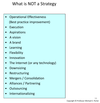Exam Preparation Flashcards
What is Strategy according to Porter?
- choosing a different set of activities to create a unique mix of value
- How is the business going to compete?
- Integrating the activities of diverse functional departments in a firm

What is not Strategy according to Porter?
8 examples work

What is Strategy?
⇒ Key definition

What are some key strategy questions?
- See alignment
- Industry
- Internal resources and capabilities
- Operation/Execution
- Environment
- Timing

What is alignment?

Alignment Questions Examined
- Are these about “strategy” or other things?
- Can we ignore operational effectiveness?
- Can we ignore “vision” or “philosophy”?
- Do you disagree with Porter at all?
- Boundaries between concepts are fuzzy ⇒ there is not just one right way
What are Porters Key concepts?
- Productivity frontier
- Trade-offs
- Opportunity costs
- Need to avoid “straddeling”
- Competitive convergence
- Alignment
- Promote sustainability
- Growth Trap
- Straddeling
How to analyze a case?
-
Assess Context
- External
- Internal
- What do you wish you knew? Is this know-able?
-
Assess Firm Performance
- What is the firm’s competitive advantage?
- How well is it meeting customers needs?
- How well is it competing with rivals?
- Identify “Symptoms”
-
Diagnose the problem
- What has changed?
- What constraints the firm’s choices?
-
Indentify Management Levers
- What options does management have?
- Consider changes in: market, value proposition, “5 forces” etc.
-
Consider impact of alternatives
- Think through the cost and benefits of particular changes
- Consider unintended consequences
- Create a plan of action (POA)
Critical Resources for Porter, deliver value to the customer and protect Porter from threats
- Terminal building
- Majority of landing slots
- Downtown location
- Technology (i.e. the plane type)
- quiet
- fast
- spacious
- well-appointed
- fuel efficient
Value to customers from Porter airlines
- Convience
- Speed
- Service
- (Flexibility)
How is Porter protected from threats by their critical resources?
- Ownership of terminal ⇒ control end-to-end experience (no competition for inputs or supplier failure)
- Edge out Air Canada and other entrants
- Low substiution risk already
Why do we care about strategy?
- Framework for analysis and assessment
- Link to action
- Justification not to do something
- Prevent “tyranny of incrementalism”
- Spur continous improvement
- Prioritize/guide allocation of limited resources
- Strategy may be implicit, rather than explicit - “you are what you do”
Industry Structure / Industry organization
On what can the intensity of rivalry depend on?
- Number of competitors
- Basis of competition
- Price (Betrand)
- Quantity (Cournot)
- Quality
- Segmentation of demand
- Scope for tacit collusion (stillschweigendes Kartell)
- Clarity of “game” and signaling
-
Coststructure of the industry
- High fixed cost and low marginal cost can lead to price competition
- Etc.
What is the boundary of a firm?
- Its “core activites”
- Value chain
- all of the activities from raw materials production to final sale and disposal that determine the cost and benefits of stakeholders
Boundary of a firm: How does the firm add value to different steps of the value chain?
How does the firm add value to different steps of the value chain?
- Technology
- Decrease costs
- Differentiation
- Increase value and WTP
- …
- Marketing
- Brand
- Increase WTP
- Price discrimination
- Product bundling
- ….
- Operational Execution
- Reduce costs
- Process innovation
- Add value through availability, timeliness, support services
- More?


